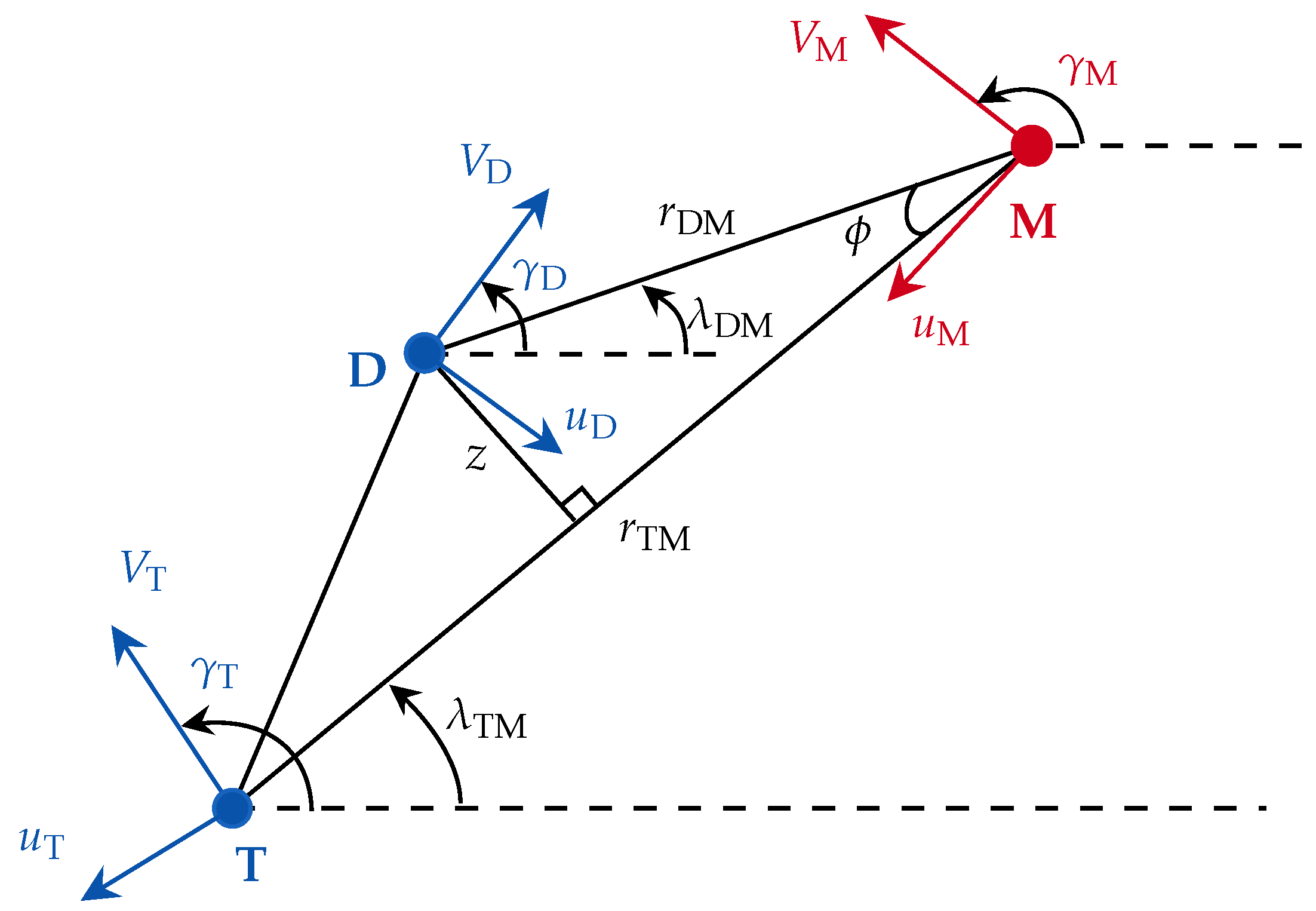Optimal Cooperative Line-of-Sight Guidance for Defending a Guided Missile
Abstract
:1. Introduction
2. Three-Body Kinematics Equations and Linearization
2.1. Nonlinear Relative Kinematics
2.2. Linear Error Distance Dynamics
3. Optimal Problem Formulation
3.1. Implicit Cooperative Defense Problem
3.2. Explicit Cooperative Defense Problem
4. Guidance Law Derivation
4.1. Implicit Cooperative Defense Guidance Law
4.2. Explicit Cooperative Defense Guidance Law
5. Simulations and Discussions
5.1. Characteristics Analysis
5.2. Comparison with Existing Solutions
6. Conclusions
Author Contributions
Funding
Institutional Review Board Statement
Informed Consent Statement
Data Availability Statement
Conflicts of Interest
References
- Boyell, R.L. Defending a moving target against missile or torpedo attack. IEEE Trans. Aerosp. Electron. Syst. 1976, AES-12, 522–526. [Google Scholar] [CrossRef]
- Boyell, R.L. Counterweapon aiming for defense of a moving target. IEEE Trans. Aerosp. Electron. Syst. 1980, AES-16, 402–408. [Google Scholar] [CrossRef]
- Rusnak, I. Guidance laws in defense against missile attack. In Proceedings of the 2008 IEEE 25th Convention of Electrical and Electronics Engineers in Israel, Eilat, Israel, 3–5 December 2008; pp. 090–094. [Google Scholar]
- Rubinsky, S.; Gutman, S. Three-player pursuit and evasion conflict. J. Guid. Control Dyn. 2014, 37, 98–110. [Google Scholar] [CrossRef]
- Pachter, M.; Garcia, E.; Casbeer, D.W. Differential game of guarding a target. J. Guid. Control Dyn. 2017, 40, 2991–2998. [Google Scholar] [CrossRef]
- Shima, T. Optimal cooperative pursuit and evasion strategies against a homing missile. J. Guid. Control Dyn. 2011, 34, 414–425. [Google Scholar] [CrossRef]
- Weiss, M.; Shima, T.; Castaneda, D.; Rusnak, I. Minimum effort intercept and evasion guidance algorithms for active aircraft defense. J. Guid. Control Dyn. 2016, 39, 2297–2311. [Google Scholar] [CrossRef]
- Zhang, H.; Li, J.; Wang, Z.; Guan, Y. Guidance navigation and control for Chang’E-5 powered descent. Space Sci. Technol. 2021, 2021, 9823609. [Google Scholar] [CrossRef]
- Bryson, A.E.; Ho, Y.C. Applied Optimal Control: Optimization, Estimation, and Control; Routledge: London, UK, 2018. [Google Scholar]
- Guelman, M. Proportional navigation with a maneuvering target. IEEE Trans. Aerosp. Electron. Syst. 1972, AES-8, 364–371. [Google Scholar] [CrossRef]
- Jeon, I.S.; Lee, J.I. Optimality of proportional navigation based on nonlinear formulation. IEEE Trans. Aerosp. Electron. Syst. 2010, 46, 2051–2055. [Google Scholar] [CrossRef]
- Palumbo, N.F.; Blauwkamp, R.A.; Lloyd, J.M. Basic principles of homing guidance. Johns Hopkins APL Tech. Dig. 2010, 29, 25–41. [Google Scholar]
- Zarchan, P. Tactical and Strategic Missile Guidance; American Institute of Aeronautics and Astronautics: Washington, DC, USA, 2012. [Google Scholar]
- Prokopov, O.; Shima, T. Linear quadratic optimal cooperative strategies for active aircraft protection. J. Guid. Control Dyn. 2013, 36, 753–764. [Google Scholar] [CrossRef]
- Shaferman, V.; Shima, T. Cooperative multiple-model adaptive guidance for an aircraft defending missile. J. Guid. Control Dyn. 2010, 33, 1801–1813. [Google Scholar] [CrossRef]
- Weiss, M.; Shima, T.; Castaneda, D.; Rusnak, I. Combined and cooperative minimum-effort guidance algorithms in an active aircraft defense scenario. J. Guid. Control Dyn. 2017, 40, 1241–1254. [Google Scholar] [CrossRef]
- Kumar, S.R.; Shima, T. Cooperative nonlinear guidance strategies for aircraft defense. J. Guid. Control Dyn. 2017, 40, 124–138. [Google Scholar] [CrossRef]
- Saurav, A.; Kumar, S.R.; Maity, A. Cooperative guidance strategies for aircraft defense with impact angle constraints. In Proceedings of the AIAA Scitech 2019 Forum, San Diego, CA, USA, 7–11 January 2019; p. 0356. [Google Scholar]
- Perelman, A.; Shima, T.; Rusnak, I. Cooperative differential games strategies for active aircraft protection from a homing missile. J. Guid. Control Dyn. 2011, 34, 761–773. [Google Scholar] [CrossRef]
- Garcia, E.; Casbeer, D.W.; Fuchs, Z.E.; Pachter, M. Cooperative missile guidance for active defense of air vehicles. IEEE Trans. Aerosp. Electron. Syst. 2017, 54, 706–721. [Google Scholar] [CrossRef]
- Yamasaki, T.; Balakrishnan, S. Triangle intercept guidance for aerial defense. In Proceedings of the AIAA Guidance, Navigation, and Control Conference, Toronto, ON, Canada, 2–5 August 2010; p. 7876. [Google Scholar]
- Yamasaki, T.; Balakrishnan, S.; Takano, H. Modified CLOS intercept guidance for aircraft defense against a guided missile. In Proceedings of the AIAA Guidance, Navigation, and Control Conference, Portland, OR, USA, 8–11 August 2011; p. 6421. [Google Scholar]
- Yamasaki, T.; Balakrishnan, S.; Takano, H. Modified command to line-of-sight intercept guidance for aircraft defense. J. Guid. Control Dyn. 2013, 36, 898–902. [Google Scholar] [CrossRef]
- Ratnoo, A.; Shima, T. Line-of-sight interceptor guidance for defending an aircraft. J. Guid. Control Dyn. 2011, 34, 522–532. [Google Scholar] [CrossRef]
- Ratnoo, A.; Shima, T. Guidance strategies against defended aerial targets. J. Guid. Control Dyn. 2012, 35, 1059–1068. [Google Scholar] [CrossRef]
- Kumar, S.R.; Mukherjee, D. Cooperative guidance strategies for active aircraft protection. In Proceedings of the 2019 American Control Conference (ACC), Philadelphia, PA, USA, 10–12 July 2019; pp. 4641–4646. [Google Scholar]
- Kumar, S.R.; Mukherjee, D. Cooperative active aircraft protection guidance using line-of-sight approach. IEEE Trans. Aerosp. Electron. Syst. 2020, 57, 957–967. [Google Scholar] [CrossRef]




| Parameters | Values |
|---|---|
| Defender | Target | |
|---|---|---|
| 7.27 × m/s | 5.95 × m/s | |
| 7.05 × m/s | 9.62 × m/s | |
| 6.12 × m/s | 2.18 × m/s |
| Control Effort | ||
|---|---|---|
| ECDG | × m/s | |
| CLOS | × m/s | |
| PNG | × m/s |
Publisher’s Note: MDPI stays neutral with regard to jurisdictional claims in published maps and institutional affiliations. |
© 2022 by the authors. Licensee MDPI, Basel, Switzerland. This article is an open access article distributed under the terms and conditions of the Creative Commons Attribution (CC BY) license (https://creativecommons.org/licenses/by/4.0/).
Share and Cite
Li, C.; Wang, J.; Huang, P. Optimal Cooperative Line-of-Sight Guidance for Defending a Guided Missile. Aerospace 2022, 9, 232. https://doi.org/10.3390/aerospace9050232
Li C, Wang J, Huang P. Optimal Cooperative Line-of-Sight Guidance for Defending a Guided Missile. Aerospace. 2022; 9(5):232. https://doi.org/10.3390/aerospace9050232
Chicago/Turabian StyleLi, Chendi, Jiang Wang, and Peng Huang. 2022. "Optimal Cooperative Line-of-Sight Guidance for Defending a Guided Missile" Aerospace 9, no. 5: 232. https://doi.org/10.3390/aerospace9050232
APA StyleLi, C., Wang, J., & Huang, P. (2022). Optimal Cooperative Line-of-Sight Guidance for Defending a Guided Missile. Aerospace, 9(5), 232. https://doi.org/10.3390/aerospace9050232





